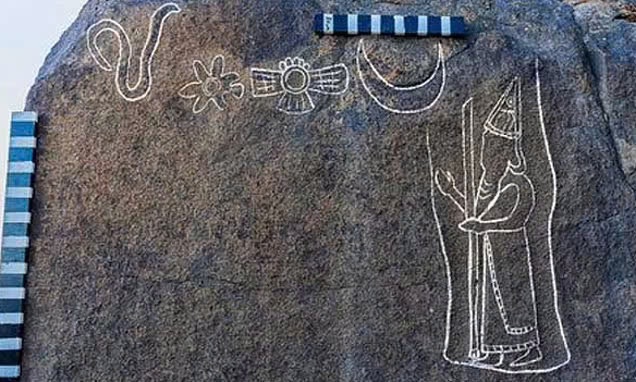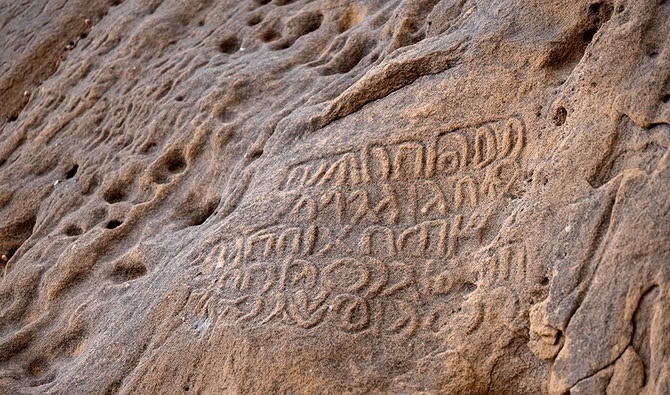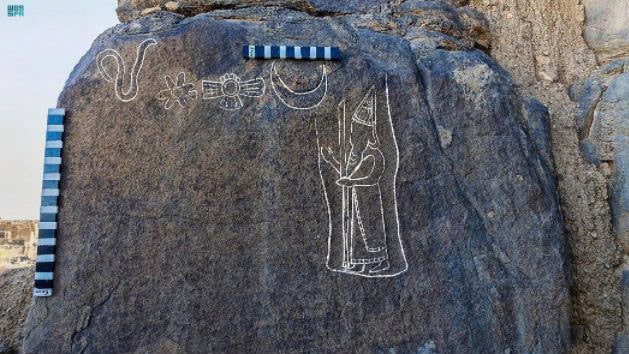In a remarkable discovery that sheds new light on the ancient history of Babylon, a 2,550-year-old cuneiform inscription has been unearthed in northern Saudi Arabia. This inscription, which bears the name of Nabonidus, the last king of Babylon, was found carved into basalt rock. The find was recently announced by the Saudi Commission for Tourism and National Heritage, and it offers a fascinating glimpse into the region’s rich past.
The Inscription and Its Symbolism

The inscription, found in the Al Hait region of Hail in northern Saudi Arabia, is unique in both its content and its symbolism. At the top of the inscription, there is an image of King Nabonidus holding a scepter, accompanied by four distinct symbols: a snake, a flower, and a depiction of the moon. According to the Saudi Commission for Tourism and National Heritage, these symbols may carry religious significance, although their exact meaning is still under investigation.
Beneath these symbols lies the longest cuneiform text ever found in Saudi Arabia, consisting of approximately 26 lines. Experts from the commission are currently working to decode this ancient text, which may reveal further insights into the region’s history during the reign of Nabonidus.
The Historical Significance of Al Hait

The inscription was discovered in Al Hait, a site of considerable historical importance. Known in ancient times as Fadak, Al Hait is home to numerous archaeological relics, including the remains of forts, rock art, and underwater installations. These artifacts span from the first millennium BCE to the early Islamic era, marking Al Hait as a significant cultural and historical crossroads.
Who Was King Nabonidus?
King Nabonidus ruled Babylon from 555 to 539 BCE. His empire stretched from the Persian Gulf to the Mediterranean Sea. At the start of his reign, Nabonidus successfully conquered the land that is now part of modern-day Saudi Arabia. Interestingly, he eventually chose to reside in Tayma, a city located in what is today Saudi Arabia.
The reasons behind Nabonidus’s decision to live in Tayma for an extended period have long been debated by historians. Some scholars suggest that a conflict between Nabonidus and the priests and officials of Babylon might have driven him to leave the city and seek refuge in Tayma.

The Fall of Nabonidus and the Babylonian Empire
The end of Nabonidus’s reign was marked by the invasion of the Babylonian Empire by the Persian Empire, led by King Cyrus the Great. In 539 BCE, the Persians captured Babylon, leading to the collapse of the Babylonian Empire. The fate of Nabonidus following the fall of his empire remains a mystery, with historical records offering little information about his later life.
Conclusion
The discovery of this ancient inscription in Saudi Arabia not only highlights the rich historical legacy of the region but also provides valuable insights into the life and reign of Nabonidus, the last king of Babylon. As experts continue to decipher the cuneiform text, we may yet uncover more about the historical connections between ancient Babylon and the Arabian Peninsula, deepening our understanding of this pivotal period in history.
